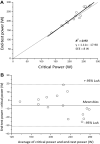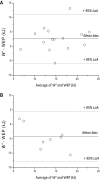The ramp and all-out exercise test to determine critical power: validity and robustness to manipulations in body position
- PMID: 34143306
- PMCID: PMC8416884
- DOI: 10.1007/s00421-021-04739-9
The ramp and all-out exercise test to determine critical power: validity and robustness to manipulations in body position
Abstract
Purpose: The purpose of the present study was to determine whether a contiguous ramp and all-out exercise test could accurately determine critical power (CP) in a single laboratory visit during both upright and supine cycle exercise.
Methods: Healthy males completed maximal ramp-incremental exercise on a cycle ergometer in the upright (n = 15) and supine positions (n = 8), with task failure immediately followed by a 3-min all-out phase for determination of end-test power (EP). On separate days, participants undertook four constant-power tests in either the upright or supine positions with the limit of tolerance ranging from ~ 2 to 15 min for determination of CP.
Results: During upright exercise, EP was highly correlated with (R2 = 0.93, P < 0.001) and not different from CP (CP = 221 ± 40 W vs. EP = 226 ± 46 W, P = 0.085, 95% limits of agreement - 30, 19 W). During supine exercise, EP was also highly correlated with (R2 = 0.94, P < 0.001) and not different from CP (CP = 140 ± 42 W vs. EP = 136 ± 40 W, P = 0.293, 95% limits of agreement - 16, 24 W).
Conclusion: The present data suggest that EP derived from a contiguous ramp all-out exercise test is not different from the gold-standard method of CP determination during both upright and supine cycle exercise when assessed at the group level. However, the wide limits of agreement observed within the present study suggest that EP and CP should not be used interchangeably.
Keywords: All-out exercise; Critical power; Exercise testing; Performance; Power–duration relationship.
© 2021. The Author(s).
Conflict of interest statement
The authors declare that there is no conflict of interest associated with this manuscript.
Figures




Similar articles
-
Prior exercise speeds pulmonary oxygen uptake kinetics and increases critical power during supine but not upright cycling.Exp Physiol. 2017 Sep 1;102(9):1158-1176. doi: 10.1113/EP086304. Epub 2017 Jul 26. Exp Physiol. 2017. PMID: 28627041
-
Determination of exercise intensity domains during upright versus supine cycling: a methodological study.PeerJ. 2022 Apr 13;10:e13199. doi: 10.7717/peerj.13199. eCollection 2022. PeerJ. 2022. PMID: 35437475 Free PMC article.
-
The constant work rate critical power protocol overestimates ramp incremental exercise performance.Eur J Appl Physiol. 2016 Dec;116(11-12):2415-2422. doi: 10.1007/s00421-016-3491-y. Epub 2016 Oct 27. Eur J Appl Physiol. 2016. PMID: 27787608 Free PMC article.
-
Hyperoxia speeds pulmonary oxygen uptake kinetics and increases critical power during supine cycling.Exp Physiol. 2019 Jul;104(7):1061-1073. doi: 10.1113/EP087599. Epub 2019 May 27. Exp Physiol. 2019. PMID: 31054263
-
Dynamics of Locomotor Fatigue during Supra-critical Power Exercise.Med Sci Sports Exerc. 2019 Aug;51(8):1720-1726. doi: 10.1249/MSS.0000000000001965. Med Sci Sports Exerc. 2019. PMID: 30817712
Cited by
-
A three-minute all-out test performed in a remote setting does not provide a valid estimate of the maximum metabolic steady state.Eur J Appl Physiol. 2022 Nov;122(11):2385-2392. doi: 10.1007/s00421-022-05020-3. Epub 2022 Aug 10. Eur J Appl Physiol. 2022. PMID: 35948835 Free PMC article.
References
MeSH terms
Grants and funding
LinkOut - more resources
Full Text Sources
Medical
Miscellaneous

